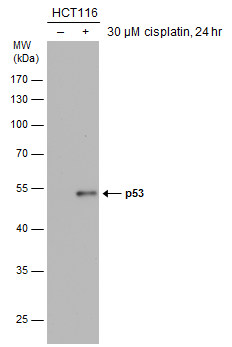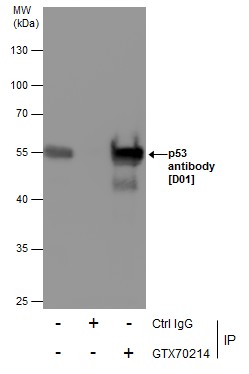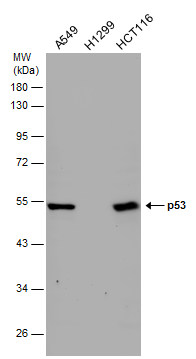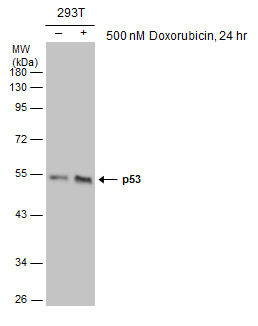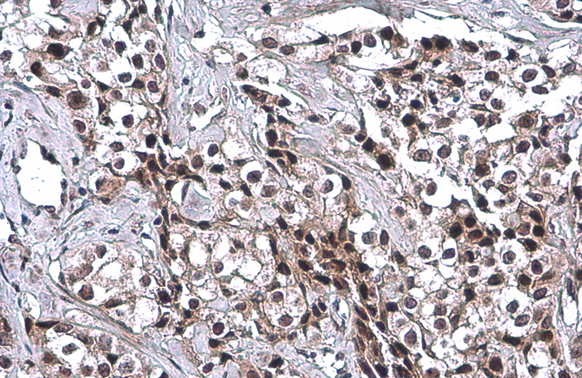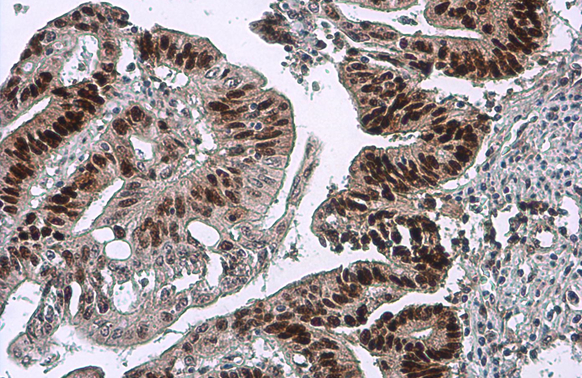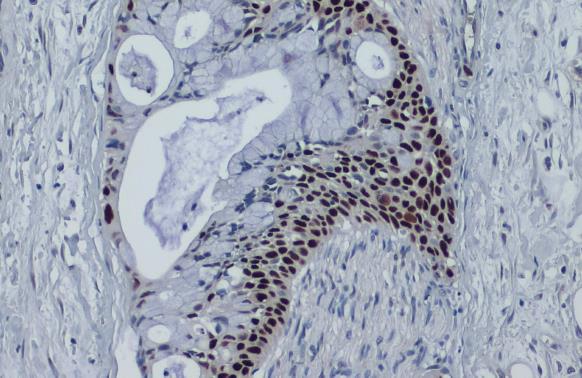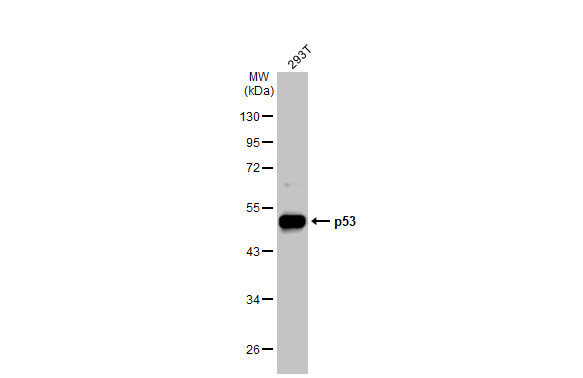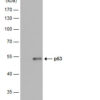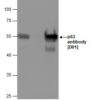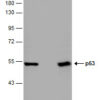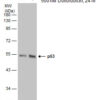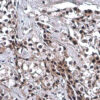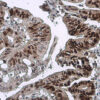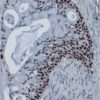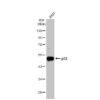Anti-p53 Antibody (3339)
$503.00
| Host | Quantity | Applications | Species Reactivity | Data Sheet | |
|---|---|---|---|---|---|
| Mouse | 100ug | WB,ICC/IF,IHC-P,IHC-Fr,FACS,IP,ELISA | Human |  |
SKU: 3339
Categories: Antibody Products, Cancer Research Antibodies, Products
Overview
Product Name Anti-p53 Antibody (3339)
Description Anti-p53 Mouse Monoclonal Antibody
Target p53
Species Reactivity Human
Applications WB,ICC/IF,IHC-P,IHC-Fr,FACS,IP,ELISA
Host Mouse
Clonality Monoclonal
Clone ID D01
Isotype IgG2a
Immunogen Recombinant human p53.
Properties
Form Liquid
Concentration Lot Specific
Formulation PBS, pH 7.4
Buffer Formulation Phosphate Buffered Saline
Buffer pH pH 7.4
Format Purified
Purification Purified by Protein A affinity chromatography
Specificity Information
Target Name Cellular tumor antigen p53
Target ID p53
Uniprot ID P04637
Alternative Names Antigen NY-CO-13, Phosphoprotein p53, Tumor suppressor p53
Gene Name TP53
Gene ID 7157
Accession Number NP_000537
Sequence Location Cytoplasm, Nucleus, Nucleus, PML body, Endoplasmic reticulum, Mitochondrion matrix, Cytoplasm, cytoskeleton, microtubule organizing center, centrosome
Biological Function Acts as a tumor suppressor in many tumor types; induces growth arrest or apoptosis depending on the physiological circumstances and cell type. Involved in cell cycle regulation as a trans-activator that acts to negatively regulate cell division by controlling a set of genes required for this process. One of the activated genes is an inhibitor of cyclin-dependent kinases. Apoptosis induction seems to be mediated either by stimulation of BAX and FAS antigen expression, or by repression of Bcl-2 expression. Its pro-apoptotic activity is activated via its interaction with PPP1R13B/ASPP1 or TP53BP2/ASPP2 (PubMed:12524540). However, this activity is inhibited when the interaction with PPP1R13B/ASPP1 or TP53BP2/ASPP2 is displaced by PPP1R13L/iASPP (PubMed:12524540). In cooperation with mitochondrial PPIF is involved in activating oxidative stress-induced necrosis; the function is largely independent of transcription. Induces the transcription of long intergenic non-coding RNA p21 (lincRNA-p21) and lincRNA-Mkln1. LincRNA-p21 participates in TP53-dependent transcriptional repression leading to apoptosis and seems to have an effect on cell-cycle regulation. Implicated in Notch signaling cross-over. Prevents CDK7 kinase activity when associated to CAK complex in response to DNA damage, thus stopping cell cycle progression. Isoform 2 enhances the transactivation activity of isoform 1 from some but not all TP53-inducible promoters. Isoform 4 suppresses transactivation activity and impairs growth suppression mediated by isoform 1. Isoform 7 inhibits isoform 1-mediated apoptosis. Regulates the circadian clock by repressing CLOCK-ARNTL/BMAL1-mediated transcriptional activation of PER2 (PubMed:24051492). {PubMed:11025664, PubMed:12524540, PubMed:12810724, PubMed:15186775, PubMed:15340061, PubMed:17317671, PubMed:17349958, PubMed:19556538, PubMed:20673990, PubMed:20959462, PubMed:22726440, PubMed:24051492, PubMed:9840937}.
Research Areas Cancer Research
Application Images









Description Untreated (–) and treated (+) HCT116 whole cell extracts (30 ug) were separated by 10% SDS-PAGE, and the membrane was blotted with p53 antibody [DO1] (3339) diluted at 1:1000. The HRP-conjugated anti-mouse IgG antibody was used to detect the primary antibody.

Description Immunoprecipitation of p53 protein from 293T whole cell extracts using 5 ug of p53 antibody [DO1] (3339).
Western blot analysis was performed using p53 antibody [D01] (3339).
EasyBlot anti-Mouse IgG was used as a secondary reagent.
Western blot analysis was performed using p53 antibody [D01] (3339).
EasyBlot anti-Mouse IgG was used as a secondary reagent.

Description Various whole cell extracts (30 ug) were separated by 10% SDS-PAGE, and the membrane was blotted with p53 antibody [DO1] (3339) diluted at 1:1000. The HRP-conjugated anti-mouse IgG antibody was used to detect the primary antibody.

Description Untreated (–) and treated (+) 293T whole cell extracts (30 ug) were separated by 10% SDS-PAGE, and the membrane was blotted with p53 antibody [DO1] (3339) diluted at 1:1000. The HRP-conjugated anti-mouse IgG antibody was used to detect the primary antibody.

Description p53 antibody [DO1] detects p53 protein at cytoplasm and nucleus by immunohistochemical analysis.Sample: Paraffin-embedded human breast carcinoma.p53 stained by p53 antibody [DO1] (3339) diluted at 1:100.Antigen Retrieval: Citrate buffer, pH 6.0, 15 min

Description p53 antibody [DO1] detects p53 protein at cytoplasm and nucleus by immunohistochemical analysis.Sample: Paraffin-embedded human colon cancer.p53 stained by p53 antibody [DO1] (3339) diluted at 1:100.Antigen Retrieval: Citrate buffer, pH 6.0, 15 min

Description p53 antibody [DO1] detects p53 protein at nucleus by immunohistochemical analysis.Sample: Paraffin-embedded human pancreatic cancer.p53 stained by p53 antibody [DO1] (3339) diluted at 1:100.Antigen Retrieval: Citrate buffer, pH 6.0, 15 min

Description 293T whole cell extracts (30 ug) was separated by 10% SDS-PAGE, and the membrane was blotted with p53 antibody [DO1] (3339) diluted at 1:40000. The HRP-conjugated anti-mouse IgG antibody was used to detect the primary antibody.
Handling
Storage This antibody is stable for at least one (1) year at -20°C. Avoid multiple freeze-thaw cycles.
Dilution Instructions Dilute in PBS or medium which is identical to that used in the assay system.
Application Instructions IHC (frozen and paraffin), Immunoblotting.
IHC: use at 1-10ug/ml. Antigen retrieval: citrate buffer, pH 6.0, 15 minutes. #3339 on paraffin-embedded human breast carcinoma. #3339 on paraffin-embedded human colon carcinoma.
Immunoblotting: use at 1-5ug/ml. A band of 53kDa is detected. #3339 on untreated (-) and treated (+) HCT116 cell extracts.
These are recommended concentrations.
Enduser should determine optimal concentrations for their applications.
IHC: use at 1-10ug/ml. Antigen retrieval: citrate buffer, pH 6.0, 15 minutes. #3339 on paraffin-embedded human breast carcinoma. #3339 on paraffin-embedded human colon carcinoma.
Immunoblotting: use at 1-5ug/ml. A band of 53kDa is detected. #3339 on untreated (-) and treated (+) HCT116 cell extracts.
These are recommended concentrations.
Enduser should determine optimal concentrations for their applications.
References & Data Sheet
Data Sheet  Download PDF Data Sheet
Download PDF Data Sheet
 Download PDF Data Sheet
Download PDF Data Sheet

